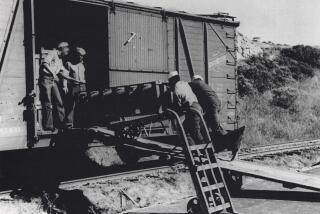6 Sailors Decorated for Bravery : Gulf War: They played key roles in saving the amphibious assault ship Tripoli, with 1,100 aboard, after it struck an Iraqi mine on eve of ground attack.
- Share via
SAN DIEGO — Six sailors were decorated for bravery Monday for their roles in saving the amphibious assault ship Tripoli, which was left dead in the water after an Iraqi mine tore a gaping hole in its hull on the eve of the ground war in the Persian Gulf.
The sailors were awarded three Bronze Stars--each with a “V” for valor on the campaign ribbons--and three Silver Stars by Rear Adm. S.S. Clarey during a ceremony aboard the Tripoli, which arrived back at its home port in San Diego on Aug. 8.
The 25-year-old ship hit a 320-pound mine at about 4:30 a.m. on Feb. 18 while it was on a mine-clearing mission for the battleship Missouri, which pounded the Kuwaiti coast in support of ground troops. The submerged mine blasted a 20-by-30 foot hole in the right side of the ship, which had 1,100 sailors and Marines aboard.
The explosion knocked out the ship’s power for about two hours. Chief Damage Control Man Joe A. Carter, who was awarded the Silver Star, said the ship began taking on water, which flooded some areas up to the third deck. Carter was cited for directing crew members to control the flooding and for entering the damaged areas to look for injured men.
Lt. Cmdr. Stephen M. Senk, chief engineer, was also awarded the Silver Star for his role in relighting the ship’s boilers and directing damage control efforts. Chief Warrant Officer Van C. Cavin was also awarded the Silver Star for his role in directing repairs below deck.
Electrician Chief Robert W. Murphy, Aviation Ordnance Man David J. Witt and Chief Gunner’s Mate William A. Werley were decorated with Bronze Stars for their successful efforts in helping to save the ship. The citations credited the men for minimizing battle damage.
As the sailors battled to save their ship, Carter, 34, and other crew members went below to assess the damage. The explosion occurred near a paint locker, and deadly fumes soon began wafting below deck.
“Most of the spaces flooded immediately, except for one. . . . I tore some insulation away from the wall and saw a big crack. I saw some fluid coming out and took my oxygen mask off to take a better look. . . . That’s when I smelled the paint fumes and ordered everybody out,” said Carter, a 12-year veteran.
After using blowers to suck out the fumes, Carter, and other crew members returned below decks. The sailors used timbers and steel shoring to reinforce the ship’s bulkheads, which were threatening to collapse under the heavy water pressure created by the flooding.
“It took us about 13 hours to shore up the ship enough so it wouldn’t suffer further damage,” said Carter.
Remarkably, the Tripoli continued minesweeping operations for five more days, until it ran out of fuel for its helicopters. However, the sea served as a constant reminder of the fragility of the repairs.
“The first night of the repairs the seas started getting a little rough. The front end of the ship would rise as it plowed along. The ship would take a big breath of air through the hole. As it settled back in the water, the air would push through the hatches. It sounded like a hurricane was blowing through the ship,” said Carter.
After running out of fuel for its helicopters, the Tripoli steamed to Bahrain, where permanent repairs were made. After the repairs were completed, the ship returned to the Persian Gulf and departed for San Diego on June 23 for the seven-week journey home.
More to Read
Sign up for Essential California
The most important California stories and recommendations in your inbox every morning.
You may occasionally receive promotional content from the Los Angeles Times.













